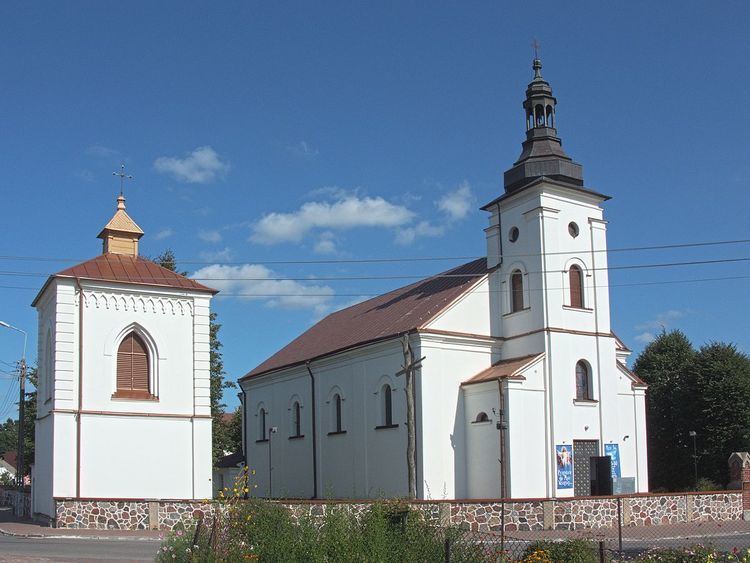Country Poland Gmina Brańsk (urban gmina) Time zone CET (UTC+1) Area 32.43 km² Local time Thursday 11:42 PM | County Bielsk Town rights 18 January 1493 Postal code 17-120 Population 3,822 (2007) Voivodeship Podlaskie Voivodeship | |
 | ||
Weather 4°C, Wind W at 24 km/h, 84% Humidity | ||
Brańsk [braɲsk] (Ukrainian: Бранськ or Брянськ, Brans’k or Brians’k) is an Urban Gmina (Polish: gmina miejska) (Town) in Bielsk County, Podlaskie Voivodeship. It is located north-eastern Poland.
Contents
- Map of BraC584sk Poland
- Etymology
- Location
- Climate
- 13th century
- 15th century
- 20th century
- Population
- Income
- Municipal government
- Executive branch
- Legislative branch
- Neighbouring political subdivisions
- Roads and highways
- Streets
- Bus service
- Rail service
- Economy
- Major business
- Church of the Assumption of the Blessed Virgin Mary Roman Catholic
- St Simeon Stylites Polish Orthodox
- Nearby attractions
- Notable people
- Miscellanea
- References
Map of Bra%C5%84sk, Poland
Etymology
The name of the town comes from the river Bronka, a nearby tributary of the Nurzec River.
Location
Brańsk is located in the geographical region of Europe known as the Wysoczyzny Podlasko – Bialoruskie (English: Podlaskie and Belarus Plateau) and the mezoregion known as the Bielsk Plain (Polish: Równinę Bielską). The Nurzec River, a tributary of the Bug River, passes through Brańsk. The town covers an area of 32.43 square kilometres (12.5 sq mi).
It is located approximately:
Climate
The region has a continental climate which is characterized by high temperatures during summer and long and frosty winters . The average amount of rainfall during the year exceeds 550 millimetres (21.7 in).
13th century
On 23 June 1264 two armies met near Brańsk. The Battle of Brańsk lasted two days pitting the forces of Yotvingia, led by Komata (Kumata) against the well equipped Krakovian army led by the Duke of Krakow, Boleslaw V the Chaste.
15th century
On 18 January 1493, Brańsk received a city charter based on Magdeburg rights from the Grand Duke of Lithuania, Alexander Jagiellon. It was the first city in Podlaskie to receive such a charter.
20th century
On September 1, 1939, Germany attacked Poland and quickly overwhelmed it. Within days of the war's beginning, Brańsk suffered German bombardment. On September 17, 1939, the USSR attacked eastern Poland, and in partnership with Nazi Germany, partitioned Poland under the terms of the Nazi-Soviet Non-Aggression Pact of August 23. Brańsk along with all areas of Poland east of the Bug River was then occupied by the Soviet Union. All Polish and Jewish businesses of substance were confiscated by the Communist State. The Soviets remained in control of Brańsk until June 1941 when the Germans invaded their erstwhile Soviet allies. Hitler's German Wehrmacht (army) occupied the town and ordered the Jewish community to build a ghetto surrounded by barbed wire, to which the Jewish population (some 65% of the town) was confined. On November 8, 1942, the Jews of Brańsk were ordered to report to the town center, forced to march to the nearby town of Bielsk, and then transported by train to Treblinka. Within weeks, the vast majority were murdered by gassing at the Treblinka death camp.
Population
Detailed data as of 31 December 2007:
Income
Income data from 2005:
Average per capita income: 1961.03 zł
Compared to the average per capita income:
Municipal government
It is the seat of Gmina Brańsk, but is not part of Gmina Brańsk.
Executive branch
The chief executive of the government is the Mayor (Polish: Burmistrz).
Legislative branch
The legislative portion of the government is the Council (Polish: Rada) composed of the President (Polish: Przewodniczšcy), the Vice President (Polish: Wiceprzewodniczšcy) and thirteen councilors.
Neighbouring political subdivisions
Brańsk is bordered by Gminy Rudka and Brańsk.
Roads and highways
Brańsk is at the intersection of a National Road and a Voivodeship Road:
Streets
The major streets (Polish: Ulica) in Brańsk:
Bus service
Regular bus service is provided by Państwowa Komunikacja Samochodowa (State Car Communication, PKS) via PKS Bielsk Podlaskie, PKS Białystok and PKS Siemiatycze
Rail service
The closest passenger train service is provided by Polskie Koleje Państwowe (Polish State Railways, PKP) SA from the following stations:
Economy
The land-use is as follows:
